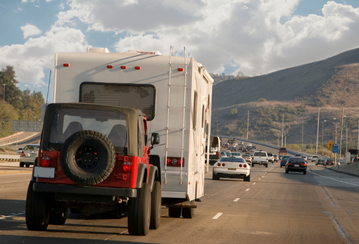News and Updates
3 ways to safely tow a car behind your RV
RVs are a great way to explore the beautiful natural landscapes Canada has to offer without giving up the comforts of home. However, while RVs provide comfort and flexibility on the road, they’re not ideal for exploring parks, driving around city or residential streets, or finding a parking space.
That’s why many RV explorers choose to tow a car behind their motorhome when embarking on a road trip. Having a standard-sized car or truck with you allows more freedom for running errands, visiting restaurants, and day-tripping around the area.
Do your research
Towing a vehicle behind your RV requires careful research to determine the towing setup that's right for you, your RV, and the vehicle you’re towing. If not done correctly, towing can cause significant damage to your towed vehicle and put yourself and other drivers at risk.
Two of the most important factors to consider are:
• The weight of the vehicle you’re towing.
• The capacity of your RV to tow it.
Check your RV manufacturer’s manual for information on weight capacity and towing restrictions.
Research the regulations for towing in your province for a full list of necessary safety equipment, steps for setting up your tow, and licensing requirements. Ontario’s towing regulations and requirements can be found in The Official Ministry of Transportation Driver’s Handbook.
Once you’ve done your initial research on your RV’s weight capacity and mandatory provincial requirements, choose a towing method that best suits your vehicle’s needs.
Let’s look at the three methods you can choose from to safely tow a vehicle behind your RV:
1. Flat towing or four-down towing
This style of towing connects a vehicle to your RV using a tow bar, with all four wheels of the towed vehicle on the road. It’s often favoured by solo RVers or RVers who plan to use their towed vehicle for daily driving, as connecting and disconnecting the towed vehicle is quick and easy.
While it doesn’t require large equipment as the other towing methods do, it’s not suitable for all vehicles. Some cars and trucks will require custom base plates and preparation to equip a tow bar. Others cannot be used for flat towing at all. Refer to your vehicle manufacturer’s instructions to determine if your vehicle is a safe fit for flat towing.
2. Dolly towing
This method of towing requires a tow dolly and is typically used for towing vehicles with front-wheel drive. When using a tow dolly, the front wheels of your towed vehicle are on the dolly while the two rear wheels roll on the road.
Tow dollies are heavy, so make sure you factor the weight of the dolly into your calculations for your RV’s weight capacity. You’ll also need to determine where to store your tow dolly when not in use, especially if driving to a campsite with limited space.
3. Trailer towing or car hauler towing
This method of towing requires a trailer or car hauler to be securely attached to your RV with all four wheels of your towed vehicle loaded inside. It is typically required for vehicles with four-wheel or all-wheel drive to avoid damage to the vehicle’s transmission.
Similar to tow dollies, trailers and car haulers are heavy so will need to be factored into your weight capacity calculations. You’ll also need a safe place to store it at your travel destination.
Get your Insurance ready
Before hitting the open road, it’s important to know you have the right insurance coverage and roadside assistance in case of an emergency. Check if your leisure vehicle insurance includes roadside assistance for your RV or trailer and review your coverage options before heading out.
If you have questions about your existing OTIP car or leisure vehicle insurance policy or want to know more about recommended coverage for RVs, connect with your OTIP insurance broker at 1-833-494-0090.
If you would like to get a quote for car insurance or leisure vehicle insurance, contact us today at 1-888-892-4935.







